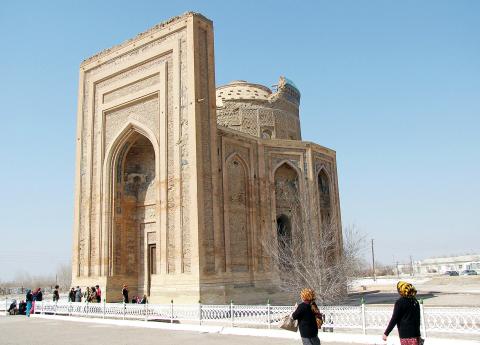The towering minaret and mausoleums of Konye-Urgench in isolated Turkmenistan cut striking forms against the desert sky, yet few foreign visitors make it to a site once at the center of the Islamic world.
Like the fabled Silk Road cities of Samarkand and Bukhara in neighboring Uzbekistan, Konye-Urgench’s rich historical legacy is sheltered behind the borders of a secretive former communist Central Asian state that creates significant obstacles to tourism.
“People come here from as far away as Australia, New Zealand and Chile,” said Aman Amanov, a state guide at the dusty UNESCO world heritage site.

Photo: AFP
However, he said that only 3,000 of the 200,000 annual visitors to the site that claimed UNESCO status in 2005 are international tourists — between one-quarter and one-fifth of the volume state officials say Turkmenistan welcomes in a year.
“The Turkmen visa was the most elusive of them all,” said Charlie Grosso, a photographer and travel writer, who visited the country in 2012.
She traveled to the isolated state as part of the Mongol Rally, a 17,000km journey for charity during which motorists travel from Western Europe to Mongolia, traditionally in small, inexpensive vehicles.
Grosso said she spent nearly half a day dealing with port officials after crossing the Caspian Sea from Azerbaijan.
“The people are lovely — we were given multiple melons during our trip,” she said. “But you are basically faced with this unyielding bureaucracy at every turn. You really feel the presence of the state.”
One of the five Central Asian republics to gain independence from Moscow in 1991, the country of 5 million people is famous for its eccentric leaders, vast gas reserves and secrecy.
However, Turkmenistan has had to grapple with a drop in global hydrocarbon prices and is looking for other sources of revenue, like tourism.
In April, Turkmen President Gurbanguly Berdimuhamedov said the government needs to diversify the economy and curb spending.
In a recent shakeup, he dismissed several senior officials overseeing the economy after the fall in prices in gas and oil — which make up more than 90 percent of its exports.
The country also steeply devalued its currency, the manat.
In a guide available in English, Russian and Turkmen provided to visitors of Konye-Urgench, a message from Berdimuhamedov reads: “Our duty in front of our forefathers is not only to preserve these riches, but to make them accessible to the whole world.”
Located 480km north of the white marble-clad capital, Ashgabat, Konye-Urgench was a seat of power for the medieval Khorezm Kingdom, whose Muslim rulers controlled much of Central Asia in the 12th century after emerging from the shadow of the mighty Seljuk Empire. Even after Ghengis Khan’s armies razed the city in 1221, Konye-Urgench became one of the most important economic hubs along the Silk Road trade routes carrying riches from China and India to markets in Europe.
UNESCO credits the government of Turkmenistan with generally good conservation practices, and calls Merv, another listed settlement in the country, “the oldest and most completely preserved of the oasis cities along the Silk Roads in Central Asia.”
However, little is done to ease access to the historic sites for foreign visitors.
The most commonly issued visa for visitors to the country is a five-day transit visa, with longer stays generally requiring a state-endorsed tour and guides such as Amanov, who stick to the script and steer clear of politics.
“Ultimately, only a more open Turkmenistan might aspire to be a tourist destination,” said Luca Anceschi, a Central Asia expert at the University of Glasgow, who called Turkmenistan’s visa regime “one of the most intractable on earth.”
However, Anceschi said Turkmenistan is unlikely to follow the lead of Kyrgyzstan and Kazakhstan, two other Central Asian states that recently introduced visa-free regimes for citizens of developed countries.
“Breaking the isolation will certainly be equated by regime veterans as a source of instability,” he said.
Aside from the country’s Silk Road heritage, tourism officials in Turkmenistan are also hoping to pique international interest in Avaza, a multibillion-dollar resort on the Caspian Sea, as well as a crater of burning gas located in the middle of the Karakum Desert that local residents nicknamed “the door to hell.”
The crater, which resulted from a Soviet-era drilling rig collapse in 1971, is attracting a growing trickle of curious sightseers, a tourism official said on condition of anonymity.

With an approval rating of just two percent, Peruvian President Dina Boluarte might be the world’s most unpopular leader, according to pollsters. Protests greeted her rise to power 29 months ago, and have marked her entire term — joined by assorted scandals, investigations, controversies and a surge in gang violence. The 63-year-old is the target of a dozen probes, including for her alleged failure to declare gifts of luxury jewels and watches, a scandal inevitably dubbed “Rolexgate.” She is also under the microscope for a two-week undeclared absence for nose surgery — which she insists was medical, not cosmetic — and is

CAUTIOUS RECOVERY: While the manufacturing sector returned to growth amid the US-China trade truce, firms remain wary as uncertainty clouds the outlook, the CIER said The local manufacturing sector returned to expansion last month, as the official purchasing managers’ index (PMI) rose 2.1 points to 51.0, driven by a temporary easing in US-China trade tensions, the Chung-Hua Institution for Economic Research (CIER, 中華經濟研究院) said yesterday. The PMI gauges the health of the manufacturing industry, with readings above 50 indicating expansion and those below 50 signaling contraction. “Firms are not as pessimistic as they were in April, but they remain far from optimistic,” CIER president Lien Hsien-ming (連賢明) said at a news conference. The full impact of US tariff decisions is unlikely to become clear until later this month

GROWING CONCERN: Some senior Trump administration officials opposed the UAE expansion over fears that another TSMC project could jeopardize its US investment Taiwan Semiconductor Manufacturing Co (TSMC, 台積電) is evaluating building an advanced production facility in the United Arab Emirates (UAE) and has discussed the possibility with officials in US President Donald Trump’s administration, people familiar with the matter said, in a potentially major bet on the Middle East that would only come to fruition with Washington’s approval. The company has had multiple meetings in the past few months with US Special Envoy to the Middle East Steve Witkoff and officials from MGX, an influential investment vehicle overseen by the UAE president’s brother, the people said. The conversations are a continuation of talks that

Nintendo Co hopes to match the runaway success of the Switch when its leveled-up new console hits shelves on Thursday, with strong early sales expected despite the gadget’s high price. Featuring a bigger screen and more processing power, the Switch 2 is an upgrade to its predecessor, which has sold 152 million units since launching in 2017 — making it the third-best-selling video game console of all time. However, despite buzz among fans and robust demand for pre-orders, headwinds for Nintendo include uncertainty over US trade tariffs and whether enough people are willing to shell out. The Switch 2 “is priced relatively high”